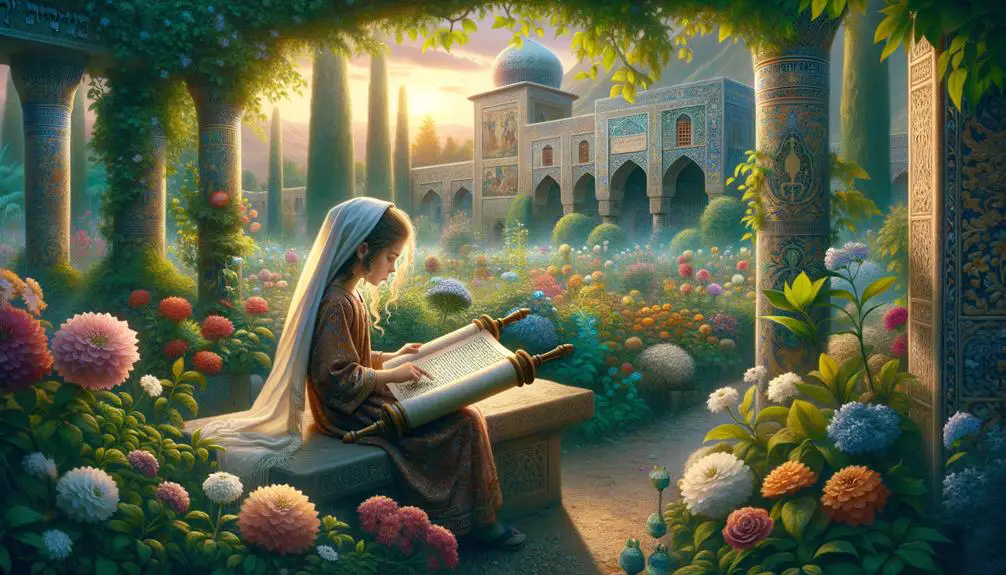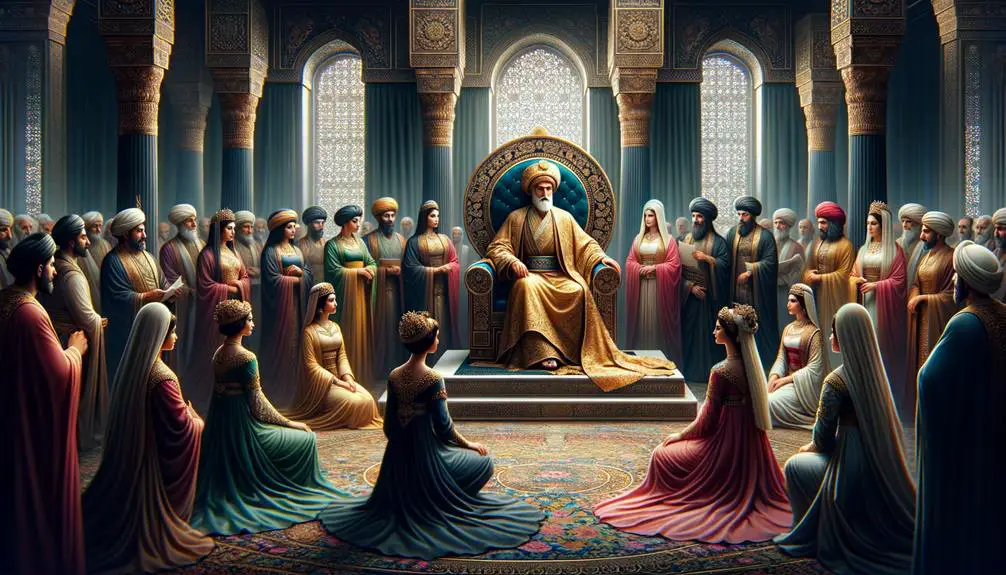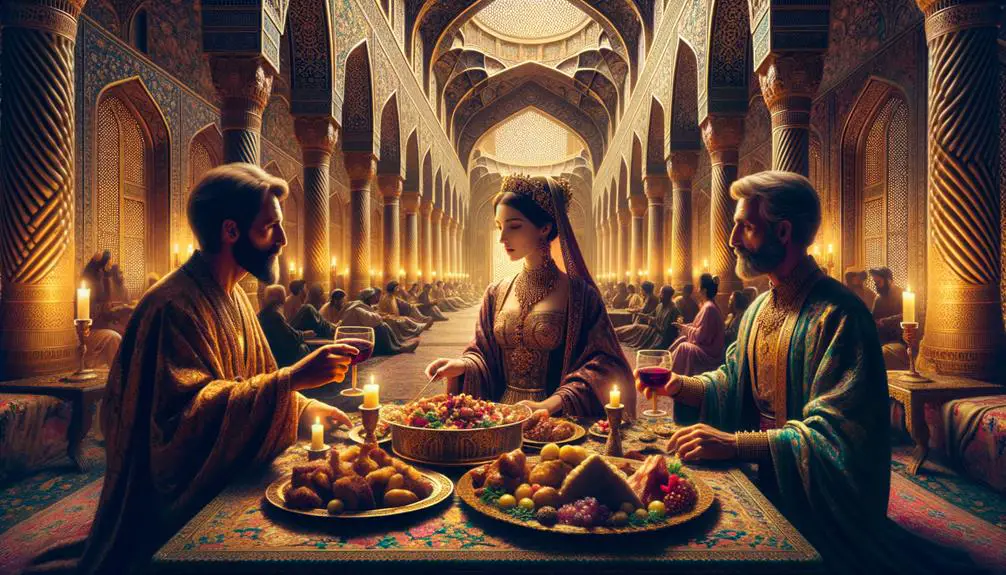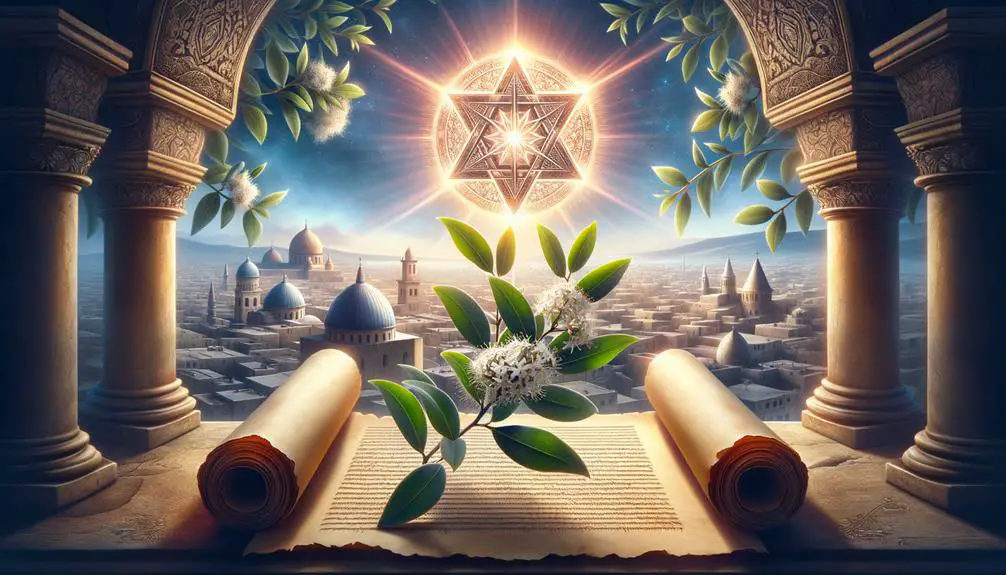Peering into the life of Hadassah, one discovers the courage and strategy of a young Jewish girl destined to become Queen Esther.

Who Was Hadassah in the Bible
In the tapestry of biblical narratives, Hadassah is a thread that weaves through darkness to emerge as a beacon of light; yet, you might know her better by her Persian name, Esther. This young Jewish girl found herself catapulted from obscurity into the heart of a royal drama, one that threatened the very existence of her people.
As you peel back the layers of her story, you'll uncover a tale of identity, courage, and cunning strategy that resonates even today. But who was she before the crown, and what made her capable of such extraordinary feats? The beginning of Hadassah's journey invites you to explore the depths of her character and the ancient world she navigated, a journey that promises more than just historical insights.
Key Takeaways
- Hadassah, also known as Esther, was a Jewish woman who became queen of Persia and saved her people from destruction.
- Her upbringing and Mordecai's guidance instilled in her the courage and wisdom needed to navigate palace politics and confront adversity.
- Esther's story is marked by her strategic intelligence, such as hosting banquets to expose Haman's plot, showcasing her resilience and bravery.
- Celebrated during Purim, Esther's legacy teaches the importance of courage, faith, and standing up against injustice, inspiring generations.
Early Life of Hadassah

Hadassah, better known by her Persian name Esther, was born into a Jewish family of the tribe of Benjamin during the Babylonian exile, setting the stage for her pivotal role in biblical history. From the onset, you'll find that her Jewish upbringing played a crucial role in shaping her identity and values. It wasn't merely a backdrop; it was the bedrock of her character, deeply influencing her actions and decisions throughout her life. This upbringing instilled in her a profound sense of faith and loyalty to her people, qualities that would later define her legacy.
Delving deeper, you'll notice how Hadassah's life was a confluence of her Jewish roots and the surrounding Persian culture. This unique blend of cultural influences is essential to understanding her journey. While her Jewish upbringing grounded her in the traditions and beliefs of her ancestors, the Persian culture she was immersed in from a young age added layers to her identity. This duality didn't dilute her Jewish heritage; instead, it equipped her with a broader perspective and the ability to navigate and eventually influence the Persian royal court.
Analyzing her early life, it's clear that Hadassah was no ordinary figure. She was a product of two worlds, each leaving an indelible mark on her persona. Her Jewish upbringing provided her with a moral compass, while the exposure to Persian culture honed her intellect and adaptability. Together, these elements forged a leader who was as wise as she was courageous, setting the stage for her to become a key figure in biblical history.
Hadassah's New Identity
Transitioning into her new identity was a pivotal moment for Hadassah, as she became known by her Persian name, Esther, marking the beginning of her profound influence within the royal court. This change wasn't merely cosmetic; it bore deep significance and reflected the cultural context in which she found herself. In the Persian empire, names were imbued with power and meaning, serving as a bridge between an individual's past and their role within society. Esther's new name, possibly derived from the Persian word for star or the goddess Ishtar, symbolized her rising prominence and the pivotal role she was to play.
Understanding the name significance and cultural context is crucial to appreciate the depth of Esther's transformation. By adopting a Persian name, she navigated the complexities of her identity in a foreign land, subtly integrating into the royal court while maintaining her Jewish heritage. This dual identity allowed her to act as a mediator, bridging her people and the Persian monarchy. The adoption of a new name signified her readiness to embrace the challenges that lay ahead, leveraging her position to influence and protect.
Esther's story is a powerful testament to the strategic use of identity in navigating political and cultural landscapes. Her transition from Hadassah to Esther wasn't just about survival; it was a deliberate move to fulfill a greater purpose. By analyzing this shift, one gains insight into the ways in which individuals can leverage their identities to effect change within complex socio-political contexts.
The King's Selection Process

In the heart of the Persian Empire, the king's selection process for a new queen was a meticulous and strategic affair, designed to find the most suitable candidate to stand beside the throne. This process wasn't just about beauty; it was a comprehensive examination of grace, intellect, and the ability to adhere to royal protocol.
The candidates underwent extensive preparations, including beauty treatments and lessons in etiquette, to ensure they met the high beauty standards and understood the intricacies of royal protocol. This wasn't merely a contest of physical attractiveness; it was a search for a queen who could navigate the complexities of the court with elegance and wisdom.
Here are three key elements of the selection process that evoke emotion:
- The intense scrutiny of candidates: Imagine being under the constant gaze, judged not just for your beauty but for your every move, word, and decision. The pressure was immense, with each candidate striving to present her best self, while internally battling the fear of rejection.
- The transformation of ordinary women into potential royalty: This aspect highlights the dramatic change in the lives of these women. From ordinary to extraordinary, their journey was both awe-inspiring and daunting, filled with hope and dread.
- The loneliness amidst the opulence: Despite the luxurious surroundings and the attention, the candidates often felt isolated, caught in a whirlwind of competition and stringent expectations, far from their former lives and loved ones.
The king's selection process wasn't just about finding a queen; it was about finding a partner who could complement the king's rule, embodying the empire's ideals and navigating its challenges with grace and intelligence.
Mordecai's Influence
You'll find Mordecai's influence on Hadassah pivotal, as it extends beyond mere guardianship to molding her into a figure of resilience and identity. His role as protector intertwines with imparting wisdom, guiding her through palace intricacies with an adeptness that underscores his deep understanding of court politics and human nature.
This mentorship fosters in Hadassah a courage that's central to her embracing her Jewish identity and undertaking bold actions, highlighting Mordecai's significant impact on her development and the narrative's unfolding.
Mordecai's Protective Role
Mordecai's vigilant guardianship over Hadassah, also known as Esther, profoundly shaped her path and destiny within the biblical narrative. His deep understanding of Jewish customs and adept navigation through Persian politics ensured Esther's survival and success. Mordecai's protective role can be summarized by:
- Educating Esther in the intricacies of Jewish traditions, grounding her in her heritage while living in a foreign land.
- Strategically navigating the complex web of Persian court politics to safeguard her and their Jewish community.
- Constantly monitoring the royal palace's dynamics, which allowed him to act decisively against threats.
This analytical approach highlights Mordecai's critical influence, emphasizing his pivotal role in Esther's life and the broader story of their people's survival. His actions weren't just protective but strategic, ensuring Esther's ascension was both meaningful and impactful.
Guidance and Wisdom
Under Mordecai's guidance, Esther not only honed her ability to navigate the complexities of Persian court life but also embodied the wisdom necessary to lead her people through perilous times. Mordecai's influence on Esther went beyond mere parental advice; it was a beacon of cultural traditions and ethical decision-making.
He instilled in her a deep understanding of her heritage and the importance of wisdom in leadership. This foundation allowed Esther to assess situations with insight and act with discernment. Mordecai's teachings weren't just lessons; they were the scaffolding upon which Esther built her strategies, ensuring her actions were both thoughtful and impactful.
His mentorship was pivotal in shaping Esther into a leader who could adeptly balance cultural fidelity with the demands of her royal position.
Fostering Courage and Identity
Through his mentorship, Mordecai not only nurtured Esther's wisdom but also instilled in her a profound sense of courage and a firm grasp of her identity. This transformation was crucial in overcoming the looming identity crisis she faced, living as Hadassah, a Jew, in a foreign palace. Mordecai's influence in courage cultivation was pivotal.
Consider these aspects:
- Identity Reinforcement: Mordecai reminded Esther of her roots, solidifying her sense of self amidst a palace that could easily erase her identity.
- Courage Cultivation: He instilled the bravery needed to face King Ahasuerus, despite the potential fatal outcome.
- Strategic Support: Mordecai provided tactical advice, enabling Esther to navigate palace politics effectively.
This mentorship wasn't just about survival but about thriving with purpose and conviction.
Haman's Evil Plot
In a sinister twist of events, Haman hatched a plot to annihilate all the Jews within the Persian Empire, driven by personal vendetta and deep-seated prejudice. This move wasn't just a spontaneous act of hatred; it was a calculated maneuver that exploited the intricate web of Persian politics and existing religious tension. Haman, holding a high-ranking position, utilized his influence over King Ahasuerus to secure a decree that promised destruction to an entire people. His motivations were complex, rooted in a refusal to be disrespected by Mordecai, a Jewish man who wouldn't bow to him, and fueled by a broader disdain for the Jewish community's distinct religious and cultural practices.
You'll find the dynamics of power and prejudice at play here particularly indicative of the era's political climate. Haman's ability to manipulate the king and the legal system underscores the precarious position of minorities within the empire. The decree, sealed with the king's ring, didn't just sanction violence against the Jews; it institutionalized it, setting a date for their extermination and incentivizing their enemies with the promise of plunder.
This plot's unveiling reveals the undercurrents of fear and discrimination that minorities often navigated. Haman's plan, while personal in its origins, became a public declaration of intolerance, showing how personal vendettas could escalate into state-sanctioned acts of violence. It's a stark reminder of the destructive power of hatred when combined with political authority, and the vulnerability of minority communities in the face of such forces.
Esther's Strategic Banquets

You'll find that Esther's banquets weren't mere social gatherings but deliberate political maneuvers aimed at swaying King Ahasuerus. Through her persuasive tactics, she masterfully turned the king's favor towards her people, countering Haman's malicious plot.
Analyzing these banquets reveals Esther's acumen in using hospitality as a strategic tool in political intrigue.
Banquet's Political Purpose
Esther's strategic banquets served as a masterful political maneuver, skillfully leveraging social gatherings to reshape the destiny of the Jewish people within the Persian Empire. Through these events, she utilized:
- Culinary symbolism to convey messages of unity and strength,
- Diplomatic alliances to build trust and secure support,
- Strategic timing to maximize the impact of her actions.
The banquets weren't mere social events but a series of calculated steps designed to influence the king and his court. By carefully choosing her moments and the guests, Esther was able to create a favorable environment for her plea. This intertwining of gastronomy and politics showcases her profound understanding of power dynamics and human psychology, effectively turning the tide in her people's favor.
Esther's Persuasive Tactics
Harnessing the power of persuasion, Esther's banquets were meticulously crafted events that played a pivotal role in securing the future of her people. Through these gatherings, she leveraged her rhetorical skills and emotional appeal to influence the king and his court. Esther's approach wasn't just about presenting an argument; it was about creating an experience that would sway the hearts and minds of her audience.
Tactic |
Impact |
|---|---|
Emotional appeal |
Engaged empathy |
Strategic timing |
Heightened tension |
Personal story |
Fostered connection |
Incremental revelation |
Built suspense |
Direct appeal |
Ensured clarity |
Esther's banquets exemplify how strategic communication, coupled with a deep understanding of human psychology, can lead to impactful outcomes. Her story underscores the power of well-crafted persuasive tactics in achieving one's objectives.
Triumph Over Adversity
Navigating through adversity, Hadassah, also known as Esther, epitomizes resilience and courage in the face of existential threats to her people. Her journey from an orphan to the queen of Persia is a testament to her personal resilience and her ability to overcome obstacles that seemed insurmountable. The story of Hadassah is a powerful narrative about a young woman who, against all odds, used her wit, intelligence, and bravery to save her people from annihilation.
Let's delve into the key moments that highlight her triumph over adversity:
- The Unveiling of the Plot: Learning of Haman's plan to destroy the Jews, Hadassah didn't succumb to fear. Instead, she formulated a plan to counteract his intentions, showcasing her strategic thinking and courage.
- The Courage to Reveal Her Identity: In a pivotal moment, she revealed her Jewish identity to the king, risking her life. This act of bravery not only demonstrated her personal commitment to her people but also her willingness to face potential death.
- The Feast of Strategy: Hosting a series of banquets, Hadassah skillfully manipulated the circumstances to her favor. Her patience and strategic planning culminated in the king granting her request to save her people, illustrating her adeptness at navigating complex political landscapes.
Through these actions, Hadassah didn't just survive; she thrived, turning a dire situation into a victorious triumph over adversity. Her story is a compelling example of how personal resilience, coupled with a strategic mind, can overcome the most daunting of obstacles.
Hadassah's Enduring Legacy

Hadassah's legacy, transcending centuries, illustrates the profound impact one individual's courage and wisdom can have on shaping history and inspiring generations. She's a beacon of feminine resilience, demonstrating how inner strength can alter the course of events and leave a mark that lasts for ages. Her story isn't just a testament to personal bravery; it also highlights her religious significance, illustrating the power of faith in overcoming adversity.
Aspect |
Description |
Impact |
|---|---|---|
Feminine Resilience |
Hadassah's ability to navigate a male-dominated society |
Inspired countless women to lead |
Religious Significance |
Her faith led to the salvation of her people |
Strengthened the faith of many |
Legacy |
The continued celebration of Purim |
Keeps her story alive globally |
You see, Hadassah, or Esther, didn't just save her people; she fortified the role of women in her time and for future generations. Her actions provide a blueprint for navigating challenges with grace and determination. The festival of Purim, celebrated annually, isn't merely a reminder of a historical victory; it's a homage to her indomitable spirit and a recognition of the power of standing up for one's beliefs and community.
Her story encourages you to reflect on your capacity for resilience and to recognize the significance of your actions in the broader tapestry of human history. Hadassah's enduring legacy is a clarion call to all, especially women, to lead with courage, live with purpose, and believe in the transformative power of faith and conviction.
Frequently Asked Questions
How Have Different Religious Traditions Interpreted Hadassah's Story and Its Moral Lessons?
Different religious traditions have delved into Hadassah's story, exploring her virtues and the moral lessons they impart.
You'll find that her courage, faith, and wisdom are universally admired, yet interpreted differently across faiths.
These interpretations often influence religious rituals, embedding Hadassah's virtues into the fabric of spiritual practices.
Analyzing these perspectives, you'll see how her story serves as a powerful tool for teaching values across diverse religious communities.
What Archaeological Evidence, if Any, Supports the Historical Existence of Hadassah or the Events Described in Her Story?
Diving into the sands of time, you're seeking evidence to illuminate ancient narratives. When it comes to uncovering the past, excavation methodologies and artifact authenticity are your torches in the dark.
Unfortunately, direct archaeological evidence pinpointing Hadassah or her specific story remains elusive. Yet, this doesn't halt the analytical dig. Instead, you shift focus, examining surrounding historical contexts and artifacts that might indirectly support the existence of similar events or figures.
How Has Hadassah Been Represented in Art, Literature, and Media Throughout History, and What Variations Can Be Seen Across Cultures?
You'll find Hadassah's portrayal in art, literature, and media has evolved significantly, showcasing a diverse range of costume evolution and modern adaptations. This evolution reflects cultural interpretations and the shifting perceptions of her story across different eras.
From Renaissance paintings to contemporary films, variations in her depiction highlight the adaptability of her narrative, ensuring its relevance and resonance. Each culture brings its own nuances, enriching her legacy through a multifaceted lens.
What Psychological Insights Can Be Drawn From Hadassah's Character Development and Decision-Making Processes Throughout Her Story?
As you delve into the psychological depths of her character, you'll find Hadassah's journey illuminates her battle with decision paralysis and her ultimate triumph in emotional resilience. Analyzing her story, you recognize patterns of hesitation followed by moments of decisive action, showcasing a complex interplay of fear and courage.
This narrative not only reflects her growth but also offers insights into the human condition, emphasizing the power of resilience in overcoming uncertainty and adversity.
How Have Feminist Scholars Critiqued or Celebrated Hadassah's Role and Actions Within the Context of Her Societal and Historical Setting?
You're diving into how feminist scholars have either critiqued or celebrated her role, given her societal and historical setting. They closely examine gender roles and power dynamics, providing a rich analysis.
They might applaud her for challenging traditional roles or critique the limitations placed upon her.
Through this lens, you're encouraged to understand the complexities of her actions within the constraints she faced, offering a nuanced view of her legacy.
Conclusion
You might argue that Hadassah, better known as Esther, is just another character in an ancient text, but her story transcends time. Her courage to risk everything, influenced by Mordecai's wisdom, showcases a remarkable triumph over adversity.
Through strategic planning and unyielding faith, Esther not only thwarted Haman's evil plot but also secured her people's safety, leaving an enduring legacy.
Her tale isn't just historical; it's a timeless narrative of bravery, intelligence, and resilience.



Sign up